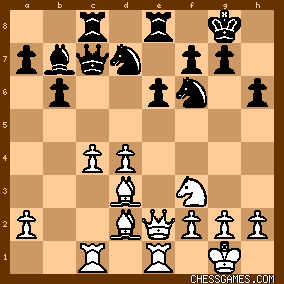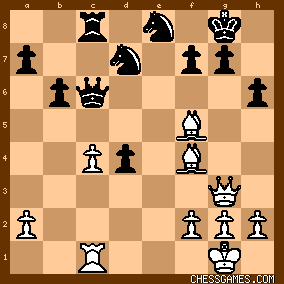| Dec-01-06 | | acerbiter: 23. h3? 24. Rd1? 25. Kh2?
33. Ba2? 34. Qe1 35. f3?
anyone can explain these series of moves (the seconds of which lost the game quickly)? |
|
| Aug-12-09 | | The Brain99: <acerbiter: 23. h3? 24. Rd1? 25. Kh2?
33. Ba2? 34. Qe1 35. f3?
anyone can explain these series of moves (the seconds of which lost the game quickly)?> <23. h3> - I'm not quite sure. Probably to protect against back-rank mate threats?
<24. Rd1> - Beginning of a plan to pressure the d-pawn
<26. Kh2> - Again, not quite sure.
<33. Ba2> - Creating an annoying pin on the knight on c4 to the queen on d5. Karpov handles it excellently by playing ...d3 then ....Qd4
<34. Qe1> - The Queen was attacked. It goes to e1 in order to help in stopping Black's passed pawn.
<35. f3> - Opening up the f2 square for the bishop. White hopes to kick Black's queen by playing Bf2 at some point. However, Karpov immediately takes advantage of this with ...Ne3! Hope this helps. If anyone wants to elaborate on 23. h3 and 26. Kh2, that would be appreciated |
|
| Aug-12-09 | | paul1959: The truth is simple: White was already lost at move 23! 19 Qg3 ?? lost a pawn without adequate compensation. Black has no trouble defending from the two Bishops and White is reduced to waiting moves (23.h3 and 26 Kh2). The only hope is to avoid exchanges and try to complicate but Karpov gives him no chances. |
|
Jul-28-10
 | | GrahamClayton: The Black knights totally dominate the position against the White bishops - Karpov obviously had this in mind when he gave up the bishop pair with 17...♗f3. |
|
Jan-21-11
 | | perfidious: Karpov's 17....Bxf3 is an outstanding example of the concrete appraisal of a position. The pawn sacrifice 19.Qg3 is odd indeed; my opinion is that Portisch's psychological equilibrium was upset by his opponent's unexpected 17th move, though after the natural 19.d5, Black at any rate is not worse. |
|
May-23-12
 | | Honza Cervenka: Do you have a Bishop pair? Who cares!:-) |
|
| Jul-23-14 | | Howard: Chess Life and Review (as it was called back then) said this event was the strongest 16-player tournament of all time (at least up until that point). That's probably quite true. On the other hand, this was clearly one of Portisch's biggest disappointments of the 1970's----he clearly didn't do very well. |
|
| Oct-23-14 | | aditya GM: I think 17.Bh4 is better than Bd2. After 17.Bh4 it goes to g3 where it aims the important e5 square and also chases the queen. |
|
Aug-24-16
 | | offramp: 
click for larger view
17...Bxf3 is a great move. That exchange, and the 18...e5! follow-up, surprised Portisch, as <Perfidious> says. A Bit later, when taking the pawn with 19...exd4 Karpov had to calculate that this position, after 22.Bf5,

click for larger view
was safe. |
|
| Aug-24-16 | | Howard: Definitely one of Karpov's better efforts in the tournament---and with Black! This, incidentally, was the second year in a row where Karpov beat Portisch with Black. In 1977, Karpov beat him in the European Team Championship in a rather short game---with Black, too ! |
|
Mar-06-20
 | | Breunor: An amazing game! Karpov was so strong at this time. He went with 2 knights vs 2 bishops and just was inexorable. |
|
Mar-06-20
 | | Fusilli: After 12...Rc8:

click for larger view...Portisch played 13.Bd3. In this type of position, I prefer to retreat to b3 (or a2 if available), or Qb3, since there is no Na5. I am not saying 13.Bd3 is bad, I am just talking about preferences. I prefer the bishop on the a2-g8 diagonal here, possibly supporting a future d5. With 17...Bxf3 Karpov makes the placement of the bishop on d3 look problematic. |
|
| Jul-08-20 | | Ulhumbrus: After 30...Nd6 if either one of Black's knights can acquire a good post it may become, if not the superior of a powerful bishop, or even the equal of a powerful bishop, then at least an adequate defender against a powerful bishop. With 32...Nc5 Karpov has both of his knights strongly posted so that the superiority of White's bishop pair is reduced to a minimum. In addition Karpov has two extra pawns and will manage to make them count, particularly the central d pawn which will become a powerful weapon. |
|
Oct-18-20
 | | woldsmandriffield: A strange game. 17..Bxf3 was incredibly risky if found otb. Portisch’s 19 Qg3!? is not so bad but he needed a more vigorous & consistent follow-up eg 19..exd4! 20 Bf4 Qc6 21 Bxh6! Nh5 22 Qh3. If by this point Karpov was out of prep, defending would be challenging. In the game, Portisch was obliging - like many of Karpov’s opponents during this period of his career. |
|
| Nov-15-21 | | nummerzwei: <A strange game. 17..Bxf3 was incredibly risky if found otb. Portisch’s 19 Qg3!? is not so bad but he needed a more vigorous & consistent follow-up eg 19..exd4! 20 Bf4 Qc6 21 Bxh6! Nh5 22 Qh3. If by this point Karpov was out of prep, defending would be challenging. > Your line leads to the following position:

click for larger viewI don't agree with the assessment above, given that Black is at least equal almost whatever he does, for example 22...Qxh6 23. Qxd7 Red8 24.Qxa7 Nf4. |
|





